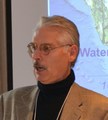SUSTAINABLE WATERSHED SYSTEMS, THROUGH ASSET MANAGEMENT: “We have a drainage standard-of-practice that is generally accepted as not achieving what is best for the environment,” stated Jim Dumont at the Comox Valley Eco-Asset Symposium (March 2017)
Note to Reader:
The Georgia Basin Inter-Regional Education Initiative (IREI) is funded by the governments of Canada and British Columbia through 2018. The IREI program focuses on how to implement “Sustainable Watershed Systems, through Asset Management”.
IREI deliverables are designed to bring hydrology state-of-the-art methodologies and tools into engineering ‘standard practice’. The twin pillars of this whole-system, water balance approach are the Ecological Accounting Protocol and the Water Balance Methodology. The two are inter-connected. Three categories of deliverables make up the IREI program.
IREI program goal is to embed
‘state-of-the-art’ hydrology in engineering ‘standard practice’
“If communities are to truly benefit from use of nature’s assets to provide vital community infrastructure services, then two issues must first be recognized as being impediment to changes in practice,” stated Jim Dumont.
 “Issue #1 is widespread lack of understanding of the relationship between flow-duration and stream (watershed) health.
“Issue #1 is widespread lack of understanding of the relationship between flow-duration and stream (watershed) health.
“Issue #2 is widespread application of a standard of practice that has led to the current situation of degraded streams, and that has little connection to real-world hydrology.”
Asset Management for Sustainable Service Delivery: A BC Framework
 “The BC Framework sets a strategic direction that refocuses business processes on outcomes that reduce life-cycle costs and risks. The program goals for the Georgia Basin Inter-Regional Education Initiative are aligned with this strategic direction,” stated the Hon. Peter Fassbender when he announced (in March 2017) that the governments of Canada and British Columbia are funding the IREI program.
“The BC Framework sets a strategic direction that refocuses business processes on outcomes that reduce life-cycle costs and risks. The program goals for the Georgia Basin Inter-Regional Education Initiative are aligned with this strategic direction,” stated the Hon. Peter Fassbender when he announced (in March 2017) that the governments of Canada and British Columbia are funding the IREI program.
IREI Deliverables
A program of teaching, training and mentoring would ensure consistent understanding of WHY and HOW to apply methodologies and tools, and would build up practitioner capacity within local governments to achieve, over time, Sustainable Watershed Systems, through Asset Management. The three categories of IREI deliverables are:
- Ecological Accounting Protocol
- Water Balance Methodology / Model / Express
- Professional Development & Outreach
Mutually reinforcing, the three deliverables set the stage for embedding state-of-the-art hydrology in engineering ‘standard practice’.
Working together, they provide an integrated solution to inadequacies in current land use and drainage practice. Moreover, the Ecological Accounting Protocol for valuing watersheds as infrastructure assets is the lynch-pin for driving change.
Category 1 –
Ecological Accounting Protocol (EAP)
EAP is one of the twin technical pillars for the whole-system, water balance approach that would refocus business processes to manage the built environment within watershed systems and avoid unfunded liability.
Life-Cycle Demonstration Applications
“EAP deals with the monetary value of renewable services provided by natural assets,” states Tim Pringle, EAP Chair.
 “Under the EAP framework, the reference to natural assets means ecosystems of watersheds. The EAP methodology focuses on drainage and water balance services because this is of direct relevance to local government decision-making.
“Under the EAP framework, the reference to natural assets means ecosystems of watersheds. The EAP methodology focuses on drainage and water balance services because this is of direct relevance to local government decision-making.
“We are moving forward with EAP demonstration applications in both the Cowichan and Comox valleys on Vancouver Island. These applications will showcase how to analyze the life-cycle costs, from pre-planning to replacement/renewal, of existing and proposed drainage infrastructure works.
“The life-cycle calculation will contribute significantly overall to local government plans for asset management, the sustainability of watershed natural assets, as well as administrative and financial capacity of local government.
“In BC, we have independently arrived at a valuation strategy that is shared by the agencies leading Principles of Natural Accounting, an initiative of the United Kingdom government. Both initiatives have both moved from concept to application of the valuation approaches, albeit at different scopes,” emphasizes Tim Pringle.
Category 2 – Water Balance Methodology / Model / Express
The Water Balance Methodology is the foundation for a family of online tools for use by different users at different scales and different purposes:
- Water Balance Methodology (existing) – independent of software platform or computer model
- Water Balance Model for BC (existing) – planners
- Water Balance Express (existing) – homeowners
- Online Watershed Assessment Tool (ready in 2017) – engineers
Restorative Development
“Use of the Water Balance family of methods and tools will help local governments bring state-of-the-art hydrology into engineering standard practice,” continues Ted van der Gulik, Partnership Chair.
 “Our objective is to make it easy for local governments to establish, require and implement Water Balance performance targets.
“Our objective is to make it easy for local governments to establish, require and implement Water Balance performance targets.
“The methods and tools exist. It is a matter of enhancing them to support EAP plus expand their use. For example, the Online Watershed Assessment Tool is a means to an end: restore watershed hydrology and re-set the ecological baseline.
“To influence standards of practice, however, we must first open minds. The Online Watershed Assessment Tool will help us open the minds of technically advanced modellers.
“At the homeowner scale, a program goal is to double the number of Water Balance Express installations in the Georgia Basin from 5 to 10 by 2018. Within a month or so, we will be announcing a cost-sharing incentive program for willing local government partners,” foreshadowed Ted van der Gulik.
Category 3 –
Professional Development & Outreach
The Partnership for Water Sustainability provides a type of engagement and outreach with local government that provincial staff no longer provide. Collaboration with participating local governments creates sharing and cross-pollinating opportunities that help eliminate the ‘disconnect between information and implementation’.
IREI program experience since 2012 has shown what works; and how to move forward incrementally and constantly improve.

“If the desired outcome is to limit stream erosion, prevent flooding and improve water quality, then a guiding principle must be to replicate the flow-duration pattern to mimic the annual Water Balance.” – Jim Dumont


